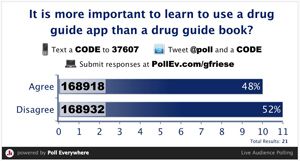Article updated August 2, 2018
“Have you ever seen a patient look like this on a respiratory distress call?” our instructor asked as he showed us a picture of a barrel chested COPD patient. Half the class silently nodded as the other half grunted acknowledgement.
Audience polling, which can be as simple as asking for a showing of hands, is an easy instructional method used to check in with the class. But yes or no questions like “have you seen this” or “have you used one of these” offer limited opportunities to engage and dive deeper into a topic.
As an instructor, I have increasingly been combining polling with interactive, internet-powered polls that offer real-time results for better audience participation.
My favorite resource is PollEverywhere.com. Poll questions are easy to create, insert into a PowerPoint slide, and display voting results in real-time, as long as my presentation computer is connected to the internet.
The students can vote by text message, tweets, or through the website. A free PollEverywhere.com account allows up to 40 responses per question, which is more than adequate for nearly all EMS instructional opportunities.
In a 45 to 60 minute presentation, I will use audience polling to do three things.
 1. Gauge the honor system
1. Gauge the honor system
It’s important to understand the class’ knowledge, skills and experiences related to the topic. If there is no honor code in place, we can spend more time developing its importance and how it can be applied.
2. Stimulate conversation with audience polls
By asking the audience to agree or disagree with a controversial statement, I’m able to get a discussion going. For instance, in a presentation about smartphone apps for EMS I like to ask the audience to agree or disagree with the statement: “It is more important for a paramedic to know how to use a drug guide app than a drug guide book.”
After voting, I ask members of the audience to argue their position:
- “Why did you select agree?”
- “Why did you select disagree?”
The resulting conversation often changes some opinions and preconceived notions about drug guide apps, as well as drug guide books.
 3. Guide EMS instruction with an online poll
3. Guide EMS instruction with an online poll
A poll question about a patient scenario can often guide instruction. Instead of asking, “Have you ever see a patient with COPD look like this?” the instructor can ask students to vote, “Which assessment will you perform first?”
The response choices can be listen to lung sounds, check SpO2, check EtCO2, or examine the fingernail beds.
Then ask students why they made their choice and have them describe the underlying pathophysiology that might be causing low SpO2, abnormal EtCO2, diminished lung sounds, or clubbed fingernails.
4. Help yourself learn
Based on this experience, there are a few things I’ve learned about using poll questions during a live presentation. Here are four of those.
- More technology is better: Students will answer with a variety of devices and methods, such as texting from a smartphone, tweeting from a tablet, or submitting from a website on a laptop. The more participation options, the better.
- Keep the poll question short: The slide question should be as short as possible, or even a paraphrase of the full question. Short questions are easier to read and engage students to participate faster.
- Say the question out loud: It is helpful to read the question out loud as the audience begins to submit their answers.
- Less is more: Fewer answers are better than more answers because it’s easier for the audience to read, and the resulting discussion is better when the audience is distributed across just two or three choices instead of five or more choices.
How do you use audience polling as a training officer or instructor? Do you have a favorite web based polling program or technology?
Share you experiences in the comments.












